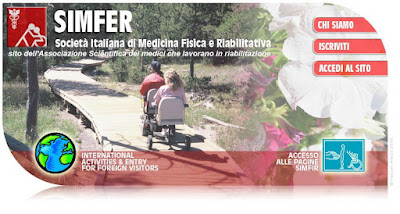
- ROBOT-MEDIATED THERAPY (RMT)
- De nuevo la revista de la SIMFER, Società Italiana di Medicina Fisica e Riabilitativa publica un artículo sobre rehablitación asistida por robots.

- Da igual que en algunos artículos se diga que la rehabilitación con robots no ha funcionado, la ingeniería tiene una característica y es que los inventos pueden mejorarse cuando se les dedica tiempo, esfuerzo y dinero. Así los mismos niños que ahora prueban estas máquinas seguramente tendrán otras mejores cuando sean mayores.
Los responsables del artículo trabajan en el servicio de rehabilitación de
L'Ospedale Pediatrico Bambino Gesù
Un hospital con 140 años de antiguedad que tiene sin ebargo las más modernas tecnologías e ideas inovadoras. No os perdaís su página web ospedalebambinogesu.it
Una de las cosas que ofrecen es el Babyblog, un blog para niños ingresados en el hospital que podéis ver aquí: babyblogopbg.blogspot.com

- Hay algunas pistas de que la tecnología está cambiando la medicina y la rehabilitación. ¿no?
- Al menos justifica ir quedándose con el concepto de:
- ROBOT-MEDIATED THERAPY (RMT).
- Eur J Phys Rehabil Med. 2009 Mar;45(1):135-41.
The impact of robotic rehabilitation in children with acquired or congenital movement disorders.
Frascarelli F, Masia L, Di Rosa G, Cappa P, Petrarca M, Castelli E, Krebs HI.
Pediatric Rehabilitation Department, Children's Hospital ''Bambino Gesù'', Passoscuro, Fiumicino, Rome, Italy flaminiafrascarelli@opbg.net.
AIM: The aim of this study was to evaluate if the robot-mediated therapy (RMT) can yield positive outcomes in children with acquired or congenital upper extremity movement disorders. METHODS: This was an uncontrolled pilot study with pre-post treatment outcome comparison carried out by the Pediatric Rehabilitation Department of a Children's Hospital. The study enrolled 12 children, aged 5 to 15 years, suffering from acquired (at least 12 months post-onset) or congenital upper limb motor impairment. Etiology: 4 stroke, 6 traumatic brain injuries, and 2 hemiplegic cerebral palsy. RMT was provided 3 times a week for an hour during 6 weeks for a total of 18 robot therapy sessions. The Melbourne Scale (MS) and the upper-extremity subsection of the Fugl-Meyer Assessment (FMA) were used for measurement of impairment. Secondary outcome measurements were made through the Modified Ashworth Scale (MAS); the Reaching Performance Scale (RPS); Parent's Questionnaire, and robot-based evaluation measurements. Specifically, authors compared the smoothness, as measured by the jerk metric, and average speed of unconstrained reaching movements. RESULTS: Pre-post clinical evaluation revealed statistically significant gains for all primary and secondary metrics. In addition, significant improvement of robot-based metrics was observed. The primary outcome measurement mean (SEM) gains were 6.71 (1.29) for MS and 3.33 (0.80) for the FMA. RMT led to spasticity decreases in chronic cases, as shown by the reduction of MAS. It led to improved trunk-upper extremity postural attitude as demonstrated by improved RPS, and it was well accepted by parents and children as observed in the Parent's Questionnaire. CONCLUSIONS: This study suggests that RMT may hold rehabilitative benefits in children suffering from acquired and congenital hemiparesis.
PMID: 19293759 [PubMed - in process]
Autor: Samuel Franco Domínguez

No hay comentarios:
Publicar un comentario
Puedes comentar lo que quieras. Pero los comentarios serán moderados y tardarán un poco en aparecer. Si el contenido es inapropiado puede que simplemente no aparezca.